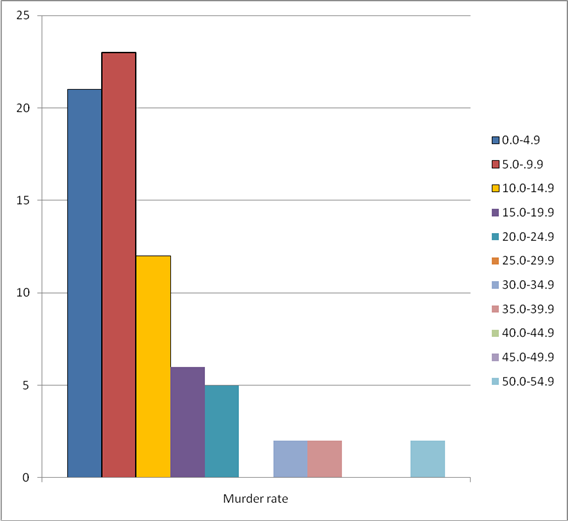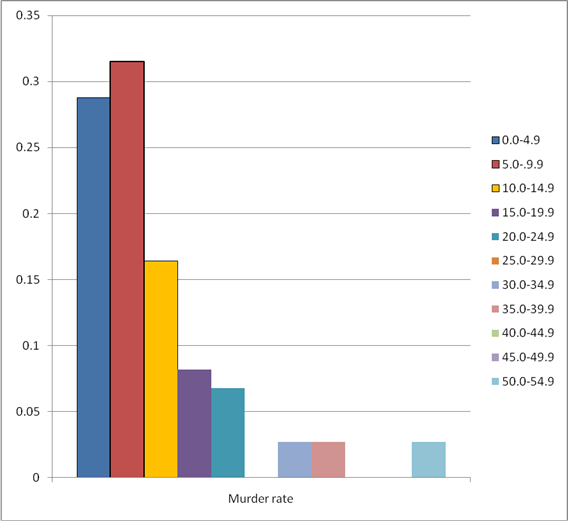
Murder, she wrote: The following frequency distribution presents the number of murders (including negligent manslaughter) per 100,000 population for each U.S. city with population over 250,000 in a recent year.

- How many classes are there?
- What is the class width?
- What are the class limits?
- Construct a frequency histogram.
- Construct a relative frequency distribution.
- Construct a relative frequency histogram.
- What percentage of cities had murder rates less than 10 per 100,000 population?
- What percentage of cities had murder rates of 30 or more per 100,000 population?
a.
To find:The number of classes.
Answer to Problem 28E
The number of classes is 11.
Explanation of Solution
Given information:The following frequency distribution presents the number of murders per 100,000 population of each U.S. city with population over 250,000 in a recent year.
| Murder rate | Frequency |
| 0.0-4.9 | 21 |
| 5.0-9.9 | 23 |
| 10-14.9 | 12 |
| 15.0-19.9 | 6 |
| 20.0-24.9 | 5 |
| 25.0-29.9 | 0 |
| 30.0-34.9 | 2 |
| 35.0-39.9 | 2 |
| 40.0-44.9 | 0 |
| 45.0-49.9 | 0 |
| 50.0-54.9 | 2 |
Definition used:The classes are intervals of equal width that cover all the values that are observed.
Calculation:
From the given table, the classes are
The number of classes is 11.
Hence, the number of classes is 11.
b.
To find:The class width.
Answer to Problem 28E
The class width is 5.
Explanation of Solution
Given information:The following frequency distribution presents the number of murders per 100,000 population of each U.S. city with population over 250,000 in a recent year.
| Murder rate | Frequency |
| 0.0-4.9 | 21 |
| 5.0-9.9 | 23 |
| 10-14.9 | 12 |
| 15.0-19.9 | 6 |
| 20.0-24.9 | 5 |
| 25.0-29.9 | 0 |
| 30.0-34.9 | 2 |
| 35.0-39.9 | 2 |
| 40.0-44.9 | 0 |
| 45.0-49.9 | 0 |
| 50.0-54.9 | 2 |
Formula used:
Calculation:
From the given table, the number of classes is 11.
The largest data value is 54.9 and the smallest data value is 0.0.
Thus, each class is an interval with equal width of 5.0.
Hence, the class width is 5.
c.
To find:The class limits.
Answer to Problem 28E
Lower limits: 0.0, 5.0, 10.0, 15.0, 20.0, 25.0, 30.0, 35.0, 40.0, 45.0, 50.0.
Upper limits: 4.9, 9.9, 14.9, 19.9, 24.9, 29.9, 34.9, 39.9, 44.9, 49.9, 54.9.
Explanation of Solution
Given information:The following frequency distribution presents the number of murders per 100,000 population of each U.S. city with population over 250,000 in a recent year.
| Murder rate | Frequency |
| 0.0-4.9 | 21 |
| 5.0-9.9 | 23 |
| 10-14.9 | 12 |
| 15.0-19.9 | 6 |
| 20.0-24.9 | 5 |
| 25.0-29.9 | 0 |
| 30.0-34.9 | 2 |
| 35.0-39.9 | 2 |
| 40.0-44.9 | 0 |
| 45.0-49.9 | 0 |
| 50.0-54.9 | 2 |
Definition used:
The lower class limit of a class is the smallest value
that can appear in that class.
The upper class limit of a class is the largest value that can appear in that class.
Calculation:
From the table, we can have the lower limits and upper limits are as follows:
Lower limits: 0.0, 5.0, 10.0, 15.0, 20.0, 25.0, 30.0, 35.0, 40.0, 45.0, 50.0.
Upper limits: 4.9, 9.9, 14.9, 19.9, 24.9, 29.9, 34.9, 39.9, 44.9, 49.9, 54.9.
d.
To construct: A frequency histogram.
Explanation of Solution
Given information:The following frequency distribution presents the number of murders per 100,000 population of each U.S. city with population over 250,000 in a recent year.
| Murder rate | Frequency |
| 0.0-4.9 | 21 |
| 5.0-9.9 | 23 |
| 10-14.9 | 12 |
| 15.0-19.9 | 6 |
| 20.0-24.9 | 5 |
| 25.0-29.9 | 0 |
| 30.0-34.9 | 2 |
| 35.0-39.9 | 2 |
| 40.0-44.9 | 0 |
| 45.0-49.9 | 0 |
| 50.0-54.9 | 2 |
Definition used: Histograms based on frequency distributions are called frequency histogram.
Solution:
The frequency histogram for the given data is given by

e.
To construct: A relative frequency distribution.
Explanation of Solution
Given information:The following frequency distribution presents the number of murders per 100,000 population of each U.S. city with population over 250,000 in a recent year.
| Murder rate | Frequency |
| 0.0-4.9 | 21 |
| 5.0-9.9 | 23 |
| 10-14.9 | 12 |
| 15.0-19.9 | 6 |
| 20.0-24.9 | 5 |
| 25.0-29.9 | 0 |
| 30.0-34.9 | 2 |
| 35.0-39.9 | 2 |
| 40.0-44.9 | 0 |
| 45.0-49.9 | 0 |
| 50.0-54.9 | 2 |
Formula used:
Solution:
From the given table,
The sum of all frequency is
The table of relative frequency is given by
| Murder rate | Frequency | Relative frequency |
| 0.0-4.9 | 21 | |
| 5.0-9.9 | 23 | |
| 10-14.9 | 12 | |
| 15.0-19.9 | 6 | |
| 20.0-24.9 | 5 | |
| 25.0-29.9 | 0 | |
| 30.0-34.9 | 2 | |
| 35.0-39.9 | 2 | |
| 40.0-44.9 | 0 | |
| 45.0-49.9 | 0 | |
| 50.0-54.9 | 2 |
f.
To construct: A relative frequency histogram.
Explanation of Solution
Given information:The following frequency distribution presents the number of murders per 100,000 population of each U.S. city with population over 250,000 in a recent year.
| Murder rate | Frequency |
| 0.0-4.9 | 21 |
| 5.0-9.9 | 23 |
| 10-14.9 | 12 |
| 15.0-19.9 | 6 |
| 20.0-24.9 | 5 |
| 25.0-29.9 | 0 |
| 30.0-34.9 | 2 |
| 35.0-39.9 | 2 |
| 40.0-44.9 | 0 |
| 45.0-49.9 | 0 |
| 50.0-54.9 | 2 |
Definition used: Histograms based on relative frequency distributions are called relative frequency histogram.
Solution:
| Murder rate | Relative frequency |
| 0.0-4.9 | 0.288 |
| 5.0-9.9 | 0.315 |
| 10-14.9 | 0.164 |
| 15.0-19.9 | 0.082 |
| 20.0-24.9 | 0.068 |
| 25.0-29.9 | 0 |
| 30.0-34.9 | 0.027 |
| 35.0-39.9 | 0.027 |
| 40.0-44.9 | 0 |
| 45.0-49.9 | 0 |
| 50.0-54.9 | 0.027 |
Therelative frequency histogram for the given data is given by

g.
To find: The percentage of cities had murder rates less than 10 per 100,00
0 population.
Answer to Problem 28E
The percentage of cities had murder rates less than 10 per 100,000 population.is 60.3%.
Explanation of Solution
Given information:The following frequency distribution presents the number of murders per 100,000 population of each U.S. city with population over 250,000 in a recent year.
| Murder rate | Frequency |
| 0.0-4.9 | 21 |
| 5.0-9.9 | 23 |
| 10-14.9 | 12 |
| 15.0-19.9 | 6 |
| 20.0-24.9 | 5 |
| 25.0-29.9 | 0 |
| 30.0-34.9 | 2 |
| 35.0-39.9 | 2 |
| 40.0-44.9 | 0 |
| 45.0-49.9 | 0 |
| 50.0-54.9 | 2 |
Calculation:
The relative frequency table is given by
| Murder rate | Relative frequency |
| 0.0-4.9 | 0.288 |
| 5.0-9.9 | 0.315 |
| 10-14.9 | 0.164 |
| 15.0-19.9 | 0.082 |
| 20.0-24.9 | 0.068 |
| 25.0-29.9 | 0 |
| 30.0-34.9 | 0.027 |
| 35.0-39.9 | 0.027 |
| 40.0-44.9 | 0 |
| 45.0-49.9 | 0 |
| 50.0-54.9 | 0.027 |
From the above data, the relative frequencies of murder rates less than 10 per 100,000 populationare 0.288 and 0.315
The sum of all the above relative frequencies is
Then, its percentage is 60.3%
Hence, the percentage of cities had murder rates less than 10 per 100,000 population.is 60.3%.
h.
To find: The percentage of cities had murder rates of 30 or more per 100,000 populations.
Answer to Problem 28E
The percentage of cities had murder rates of 30 or more per 100,000 populations is 8.1%.
Explanation of Solution
Given information:The following frequency distribution presents the number of murders per 100,000 population of each U.S. city with population over 250,000 in a recent year.
| Murder rate | Frequency |
| 0.0-4.9 | 21 |
| 5.0-9.9 | 23 |
| 10-14.9 | 12 |
| 15.0-19.9 | 6 |
| 20.0-24.9 | 5 |
| 25.0-29.9 | 0 |
| 30.0-34.9 | 2 |
| 35.0-39.9 | 2 |
| 40.0-44.9 | 0 |
| 45.0-49.9 | 0 |
| 50.0-54.9 | 2 |
Calculation:
The relative frequency table is given by
| Murder rate | Relative frequency |
| 0.0-4.9 | 0.288 |
| 5.0-9.9 | 0.315 |
| 10-14.9 | 0.164 |
| 15.0-19.9 | 0.082 |
| 20.0-24.9 | 0.068 |
| 25.0-29.9 | 0 |
| 30.0-34.9 | 0.027 |
| 35.0-39.9 | 0.027 |
| 40.0-44.9 | 0 |
| 45.0-49.9 | 0 |
| 50.0-54.9 | 0.027 |
From the above data, the relative frequencies of murder rates of 30 or more per 100,000 populationsare 0.027, 0.027, 0, 0 and 0.027.
The sum of all the above relative frequencies is
Then, its percentage is 8.1%
Hence, the percentage of cities had murder rates of 30 or more per 100,000 populations is 8.1%.
Want to see more full solutions like this?
Chapter 2 Solutions
Elementary Statistics (Text Only)
- Name Harvard University California Institute of Technology Massachusetts Institute of Technology Stanford University Princeton University University of Cambridge University of Oxford University of California, Berkeley Imperial College London Yale University University of California, Los Angeles University of Chicago Johns Hopkins University Cornell University ETH Zurich University of Michigan University of Toronto Columbia University University of Pennsylvania Carnegie Mellon University University of Hong Kong University College London University of Washington Duke University Northwestern University University of Tokyo Georgia Institute of Technology Pohang University of Science and Technology University of California, Santa Barbara University of British Columbia University of North Carolina at Chapel Hill University of California, San Diego University of Illinois at Urbana-Champaign National University of Singapore…arrow_forwardA company found that the daily sales revenue of its flagship product follows a normal distribution with a mean of $4500 and a standard deviation of $450. The company defines a "high-sales day" that is, any day with sales exceeding $4800. please provide a step by step on how to get the answers in excel Q: What percentage of days can the company expect to have "high-sales days" or sales greater than $4800? Q: What is the sales revenue threshold for the bottom 10% of days? (please note that 10% refers to the probability/area under bell curve towards the lower tail of bell curve) Provide answers in the yellow cellsarrow_forwardFind the critical value for a left-tailed test using the F distribution with a 0.025, degrees of freedom in the numerator=12, and degrees of freedom in the denominator = 50. A portion of the table of critical values of the F-distribution is provided. Click the icon to view the partial table of critical values of the F-distribution. What is the critical value? (Round to two decimal places as needed.)arrow_forward
- A retail store manager claims that the average daily sales of the store are $1,500. You aim to test whether the actual average daily sales differ significantly from this claimed value. You can provide your answer by inserting a text box and the answer must include: Null hypothesis, Alternative hypothesis, Show answer (output table/summary table), and Conclusion based on the P value. Showing the calculation is a must. If calculation is missing,so please provide a step by step on the answers Numerical answers in the yellow cellsarrow_forwardShow all workarrow_forwardShow all workarrow_forward
 Glencoe Algebra 1, Student Edition, 9780079039897...AlgebraISBN:9780079039897Author:CarterPublisher:McGraw Hill
Glencoe Algebra 1, Student Edition, 9780079039897...AlgebraISBN:9780079039897Author:CarterPublisher:McGraw Hill Big Ideas Math A Bridge To Success Algebra 1: Stu...AlgebraISBN:9781680331141Author:HOUGHTON MIFFLIN HARCOURTPublisher:Houghton Mifflin Harcourt
Big Ideas Math A Bridge To Success Algebra 1: Stu...AlgebraISBN:9781680331141Author:HOUGHTON MIFFLIN HARCOURTPublisher:Houghton Mifflin Harcourt Holt Mcdougal Larson Pre-algebra: Student Edition...AlgebraISBN:9780547587776Author:HOLT MCDOUGALPublisher:HOLT MCDOUGAL
Holt Mcdougal Larson Pre-algebra: Student Edition...AlgebraISBN:9780547587776Author:HOLT MCDOUGALPublisher:HOLT MCDOUGAL


